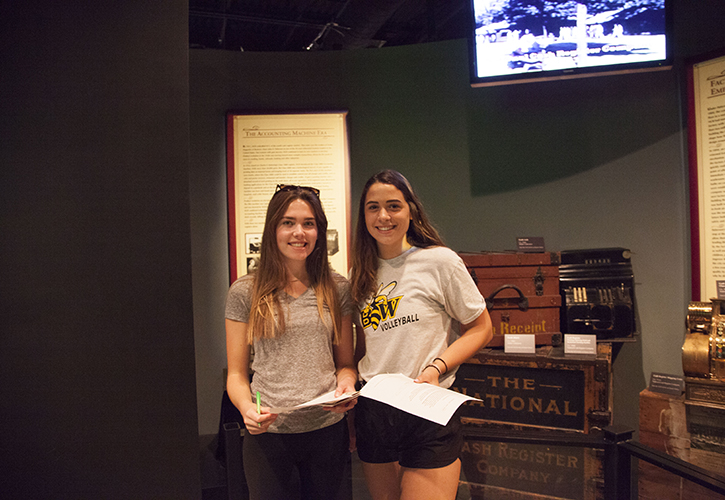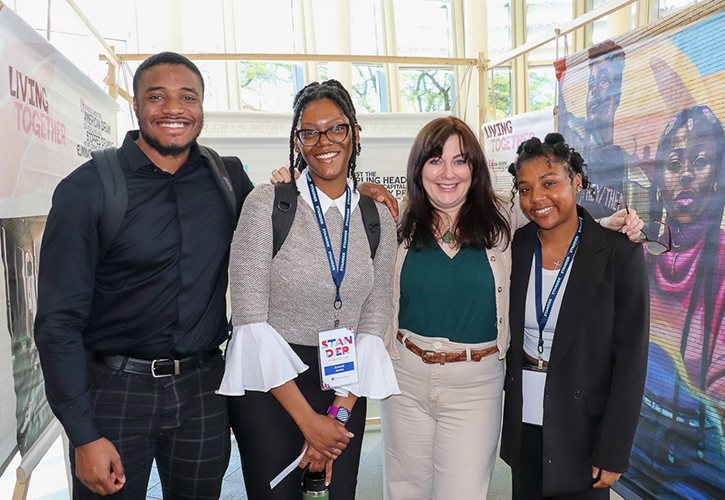Art and Design
What We Do
Collectively, the Department of Art and Design faculty, staff, and students advance the conviction that visual culture matters in society and that it matters to make, display, critique, and contextualize the visual arts as academic activities in a university setting.
Our faculty teach the perceptual, practical, and critical skill necessary for the creation and understanding of art and design in a variety of media and contexts.
We teach the history of the applied and fine arts and cultivate the ability to appreciate and articulate their meaning and value. The department emphasizes the highly integrative nature of art and design and their immense cultural and personal importance.
We offer six degrees plans across the arts, including the professional degrees - BFA in Fine Arts, BFA in Photography, BFA in Graphic Design, BFA in Art Education, BA in Art History – as well as the generalist degree, the BA in Visual Arts. Explore our degree programs.
The University of Dayton is accredited by the National Association of Schools of Art and Design (NASAD). The major responsibility of NASAD is the accreditation of education programs in art and design, including the establishment of curricular standards and guidelines for specific degrees and credentials. Institutional membership is gained only through the peer review process of accreditation.
The Association also provides counsel and assistance to established and developing institutions and programs. NASAD is recognized by the United States Department of Education as the agency responsible for the accreditation of all art and design curricula.
NASAD works with other peer associations such as the AIGA, the professional association for design, the American Craft Council (ACC), the Association of Independent Colleges of Art and Design (AICAD), the Industrial Designers Society of America (IDSA), and the National Art Education Association (NAEA).
NASAD participates in the national conversation about educational issues with special emphases on art and design, the arts, and higher education.
The B.F.A. in Art Education degree program is also accredited by the National Council for Accreditation of Teacher Education.
The dimensions of diversity important to our department include the racial, ethnic, gender, and socio-economic differences reflected within society. It is important that we reflect this diversity in our makeup and our teaching efforts. We strive to attract a student body that represents the diversity of our region and our nation and attract and retain faculty of diverse perspectives. Read our statement below:
Departmental Diversity Statement
We believe the effective pursuit of knowledge requires the inclusion of multiple perspectives. Towards this end, we are committed to cultivating the understanding of diverse peoples in society. Through our curricular offerings, we engage students in scholarship, critical discourse, and experiential learning concerned with cultural diversity. We recognize the diversity of both local and global communities, as we educate students to engage the complexities of living in and contributing to a pluralistic society and workplace. We honor the spirit of diversity, in all its forms, including race, ethnicity or cultural identity, gender, socio–economic status, disability/ability, religious belief, sexual orientation or age.
At the University of Dayton, our mission is to "educate for transformation." The Department of Art and Design is a campus leader in creating innovative and interdisciplinary courses that connect the arts, photography and design to contemporary histories, social justice inquiries and acts of civic engagement. Our students become conversant in aesthetic judgments, but also cultural awareness and social responsibility. Critical conversations take place in every classroom, driving our students to excel as leaders in contemporary culture.
The mission of our department is to provide quality education in the areas of art education, art history, fine arts studio, photography, and graphic design. The department cultivates high standards for creativity, craft, conceptual under-standing, critical analysis, historical scholarship, and pedagogy in all of these areas as they relate to art and design and visual culture.
Central to these pursuits are the artistic practice and scholarly research of faculty, the dedication of support staff to the department’s educational objectives, and engaged teaching, learning, and scholarship. The Department of Art and Design is a thriving learning community grounded in the Marianist tradition of educating the whole person. It is fully integrated with the College of Arts and Sciences and the University and contributes significantly to our institutional commitment to excellence.
Goals
Our faculty are professionals in the fields of art history, fine arts, graphic design, photography and art education. While we offer six degrees plans across major areas within the arts, it is important to note that we all are committed to the following goals.
The Department of Art and Design will:
- enrich and link all of its distinctive degree programs through an integrated approach to foundation courses and experiences;
- respond creatively and thoughtfully to the challenge of balancing traditional practices and ideas in art and design with new technologies and perspectives;
- strongly support both liberal and professional education through its attention to both theory and practice; and
- ensure that high standards are met in all of its programs through assessments that include rigorous, department-wide reviews of students in their second and senior years.
Learning objectives
Students acquire the skills required to give visual form to intellectual and emotional experience. They are introduced to a variety of materials, tools, and processes and are expected to become familiar with all basic aspects of art and design practice and to achieve genuine proficiency with selected media. As they advance, students refine their skills and employ them in more sophisticated practice; they are strongly encouraged to experiment and take risks. Mastery of art and design skills and processes are essential not only to the successful production of work, but also to the student’s self-awareness as an artist and to a sense of dedication and pride in the work produced.
Students learn to address conceptual challenges and understand the larger contexts in which they work. Students employ visual syntax, metaphor, allusion, symbolism, and other intellectual tools that provide them with a working awareness of their field of study. They acquire knowledge in the history of art, design, and photography that serves as a primary resource for their own work and for a broader understanding of the role of visual arts in all civilizations. They recognize the practices of art and design as significant forms of shaping and responding to culture. Students are challenged to engage in the basic educational activities of inquiry, analysis, discovery, criticism, and integration. They become aware of the complex conceptual relationships that may exist among visual images and between such images and other forms of communication and behavior.
Students examine their own work as well as the work of past and present artists, designers, photographers, and scholars to constantly challenges assumptions and disclose fresh perspectives. An understanding of concepts and contexts develops through the practice of penetrating and articulate critical thinking. Students learn the values associated with tradition. They also learn to appreciate contemporary perspectives that confront tradition and provoke fresh thinking. Students become accomplished in the ability to identify works of art and design and analyze the significance and influences that played a role in their production. The various skills of critical thinking in the visual arts are strongly supported by the full spectrum of liberal arts studies.
Students learn the values of dedication and self-discipline through the practices of art and design and scholarly research and writing. This teaches the values of shared experience and collaboration as well as the values of independence and individuality. Students learn that personal values and self-expression are intimately connected with social, cultural, political, economic, and religious values. Through art and design practice and study, students are aware of the importance of global and multi-cultural issues and ways in which their singular experiences relate to universal concerns, leading to greater awareness of class, gender, racial and ethnic diversity. Students achieve a rich and inclusive sense of themselves.
Students prepare for professional practice within their chosen fields as they acquire essential skills, pursue integrated liberal arts learning, and develop a sense of their values as responsible citizens of the world. Student work is reviewed in contexts appropriate to their ambitions, which may include graduate education or embarking directly on a careers in art and design practice. Internships and related practical experiences are strongly encouraged.
Student foundation work is assessed by faculty in their first semester, second year through the Exchange and in their final semester through their respective capstone courses to ensure students achieve our department's program learning outcomes.
- Utilizes visual and formal principles required by the discipline.
- Written and oral communication are informed, organized and persuasive.
- Utilizes relevant media and technology required by the discipline.
- Understands disciplinary historical forces, traditions and contemporary issues.
- Applies disciplinary professional standards in research and practice.
- Connects historical developments, contemporary events and social justice to making and analysis.
- Applies disciplinary concepts, principles and methods in solving problems through critical and interdisciplinary synthetic thinking.
Art and Design Foundations
Foundation courses introduce students to fundamental principles, practices, materials, and vocabulary. They provide a background of skill development and an understanding of primary concepts as well as a basis for critical evaluation. All foundation courses share the objective of preparing students to face the challenges of their specific disciplines.
Visit Course CatalogOur Faculty: Advisors and Mentors
Faculty advisors work with students through out their four years of study. They mentor their students as they master new skills and develop a deep understanding of the professional qualities of their discipline. In addition to course work and internship opportunities, students exhibit their work on campus and engage in lively critiques of new art during their years at UD.
Meet our faculty

